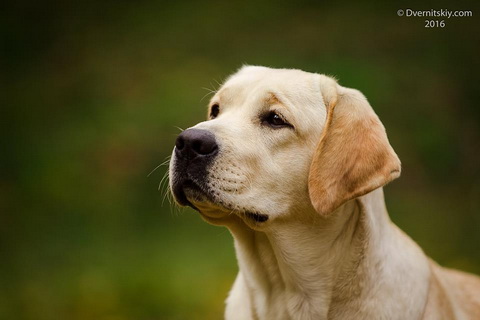Standard breed Labrador Retriever

Labrador is one of the most obedient and reliable dogs. Very clever, benevolent, easy to train. All over the world it is considered one of the most intelligent and gifted dogs. They have many professions: they are used for draft work, hunting, at customs they are looking for drugs and explosives, working on mountain, water, rescue services. The balanced nature and innate forethought of the Labrador are most suitable for the work of the blind leader - 80% of guide dogs in the world are labradors. They have a great instinct and perfectly know what the host wants from them on the hunt. It is an outstanding dog for hunting water game and in a marshy area.
And the main thing is a reliable and obedient dog, a devoted and intelligent companion. Under the supervision of a Labrador you can safely leave the children, this is a born nanny, he knows the tastes of all family members and will communicate with each in his own way. This is an unusually cheerful, friendly and sociable dog. Walking with him will be a great pleasure. Sensitively perceiving the mood of the owner, he will not get under his feet, but in any case he will be happy to help. Special care Labrador does not require, if you regularly brush your hair with a brush, your pet will look great.
BRITISH STANDARD LABRADOR-Retriever
(Approved by the English Kennel Club in 1998).
General form.
Labrador is a tightly built, compact, very active dog with a wide skull, open chest, broad and deep chest, broad and strong loin and hindquarters.
Characteristics.
The character is balanced, mobile. Also, a well developed flair, a "soft mouth", a huge love for water. Easy to adapt, a dedicated companion.
Temperament.
Labrador is a highly intelligent, intelligent and obedient dog, endowed with the desire to work and benefit. He is peaceful and good-natured, without any signs of aggression or cowardice.
Head and skull.
The skull is wide, with a pronounced transition from the forehead to the muzzle. The head is even, without bulges and depressions, the skin is tight, without the appearance of cheek. Jaws of medium length, powerful, do not narrow to the end. Nose is wide, with well developed nostrils.
Eyes.
Medium in size, with a clever and good-natured expression, brown or nutty. (* American standard allows yellow and black eyes.)
Ears.
Not large and not heavy, almost tightly fitting on the sides of the head and backward.
Teeth.
Jaws and teeth are strong, the incisors are located on one line, the scissors bite, that is, the lower incisors tightly close their front surface with the posterior surface of the upper ones. (* American standard allows for direct bite.)
Neck.
Dry, strong and powerful, highly placed.
Belt of apron of limbs.
Shoulder blades are long, obliquely set forelegs with strong bones, when viewed from the front or from the side, straight from the elbows to the ground.
Building.
The thorax is wide and deep, with well-prominent ribs. The top line is straight. Loin is wide, short and sturdy.
Belt of hind limbs.
Well developed, the croup is not sloping. The corners of the knee joints are pronounced. Hock joints are lowly lowered, puscles short. Cow feeding is unacceptable.
Paws
Round, compact, fingers arched, with well-developed pads.
Tail.
The tail is a characteristic feature of the breed, very thick at the base, gradually tapering towards the end, of medium length, without suspension. Over the entire length it is covered with a short, tight-fitting, thick coat typical of a Labrador and from that it seems "rounded", like the tail of an otter. A dog can keep it "fun", but not thrown over his back.
Movements.
Movement - free, sweeping, rectilinear, correct when viewed from the front and back.
Wool.
The coat is a characteristic feature of the Labrador. The coat is short, very dense, but not wavy, without stripes, to the touch quite stiff, with weatherproof weatherproof.
Color
Purely black, yellow or liver (chocolate). Yellow can range from light cream to fox-red. Allowed, but not desirable, a small white patch on the chest.
Growth.
Ideal height at the withers: males - 56-57 cm, female - 54-56 cm. Males should have two fully developed testicles in the scrotum.
Vice.
Any deviation from the standard should be evaluated in accordance with the degree of severity of this deviation, taking into account the importance of these or those qualities for the purpose of the breed. Including: undershot or undershot, lack of undercoat, irregular movements, presence of adorning wool, wedge-shaped head, large or heavy ears, cow’s cuffs, tail tucked over back. Any deviation from the height at the withers specified in the standard, a depigmented nose, depigmentation of the eyelid edges, a tail that has been docked or modified in any other way, an artificial change in the natural tail supply, any other color or combination thereof, except for the black, yellow or chocolate, described in the standard - Disqualifying defects.













